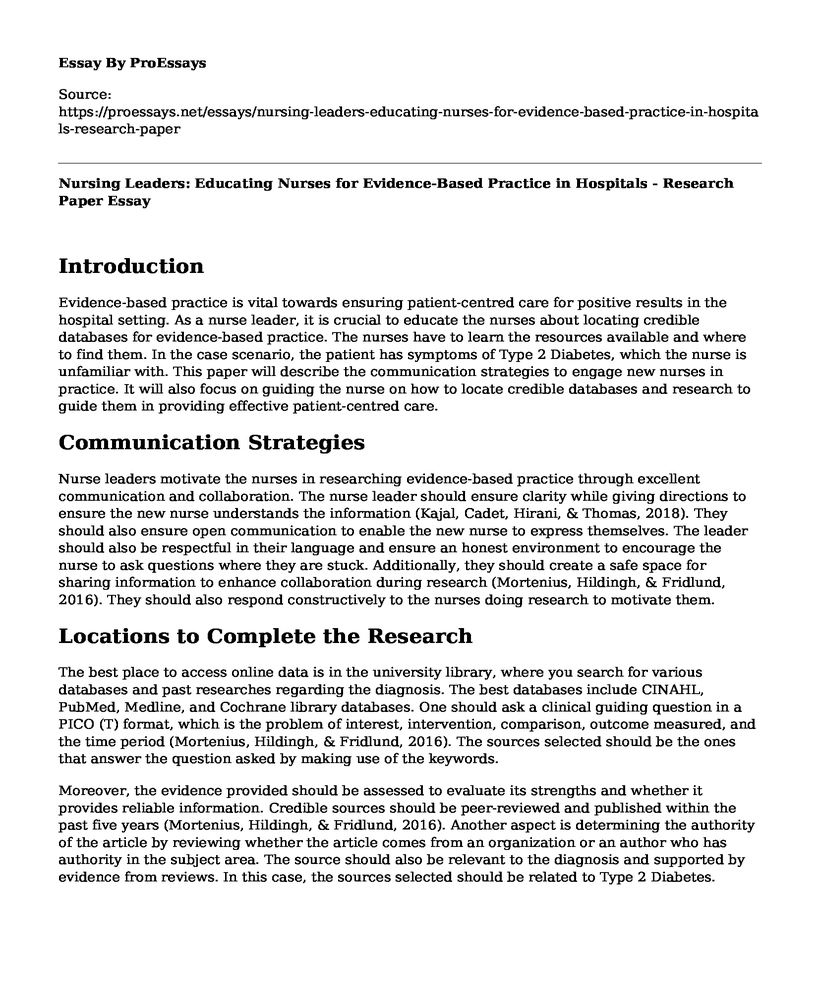Introduction
Evidence-based practice is vital towards ensuring patient-centred care for positive results in the hospital setting. As a nurse leader, it is crucial to educate the nurses about locating credible databases for evidence-based practice. The nurses have to learn the resources available and where to find them. In the case scenario, the patient has symptoms of Type 2 Diabetes, which the nurse is unfamiliar with. This paper will describe the communication strategies to engage new nurses in practice. It will also focus on guiding the nurse on how to locate credible databases and research to guide them in providing effective patient-centred care.
Communication Strategies
Nurse leaders motivate the nurses in researching evidence-based practice through excellent communication and collaboration. The nurse leader should ensure clarity while giving directions to ensure the new nurse understands the information (Kajal, Cadet, Hirani, & Thomas, 2018). They should also ensure open communication to enable the new nurse to express themselves. The leader should also be respectful in their language and ensure an honest environment to encourage the nurse to ask questions where they are stuck. Additionally, they should create a safe space for sharing information to enhance collaboration during research (Mortenius, Hildingh, & Fridlund, 2016). They should also respond constructively to the nurses doing research to motivate them.
Locations to Complete the Research
The best place to access online data is in the university library, where you search for various databases and past researches regarding the diagnosis. The best databases include CINAHL, PubMed, Medline, and Cochrane library databases. One should ask a clinical guiding question in a PICO (T) format, which is the problem of interest, intervention, comparison, outcome measured, and the time period (Mortenius, Hildingh, & Fridlund, 2016). The sources selected should be the ones that answer the question asked by making use of the keywords.
Moreover, the evidence provided should be assessed to evaluate its strengths and whether it provides reliable information. Credible sources should be peer-reviewed and published within the past five years (Mortenius, Hildingh, & Fridlund, 2016). Another aspect is determining the authority of the article by reviewing whether the article comes from an organization or an author who has authority in the subject area. The source should also be relevant to the diagnosis and supported by evidence from reviews. In this case, the sources selected should be related to Type 2 Diabetes.
Reasons the Sources Provide the Best Evidence for Type 2 Diabetes
The sources selected will provide the best evidence for diabetes as they will be selected from credible databases. The databases give sound information with an overview of the aspects that surround the diagnosis, such as the symptoms, diagnosis, and treatment (Blaslov, Naranda, Kruljac, & Renar, 2018). The databases contain information that is supported by data from trials and peer reviews. There will be a literature review to determine whether the sources provide accurate and detailed information regarding the condition. The information gives the nurses pertinent knowledge towards familiarizing with the condition and providing patient-centred care.
In enhancing patient-centred care based on evidence-based practice, five sources have been identified to provide evidence to help the new nurse in the clinical diagnosis. The sources describe the signs and symptoms of the condition (Chatterjee, Khunti, & Davies, 2017). They also describe the techniques used to diagnose the disease and the treatment plan based on the needs of the patient. They will, therefore, be useful in guiding the nurse to familiarize themselves with the patient's condition.
Conclusion
Locating credible sources is vital in evidence-based practice in nursing. Nurse leaders should, therefore, guide the new nurses on how to provide patient-centred care. The best databases to find complete researches include the Cochrane Library, PubMed, and CINAHL. The databases provide reliable information with an overview of the aspects that surround a particular diagnosis, including treatment.
References
Blaslov, K., Naranda, F. S., Kruljac, I., & Renar, I. P. (2018). The treatment approach to type 2 diabetes: Past, present, and future. World journal of diabetes, 9(12), 209. Retrieved from 10.4239/wjd.v9.i12.209
Chatterjee, S., Khunti, K., & Davies, M. J. (2017). Type 2 diabetes. The Lancet, 389(10085), 2239-2251. Retrieved from DOI: 10.1016/S0140-6736(17)30058-2 Kajal, G. C., Cadet, M. J., Hirani, S., & Thomas, T. (2018). Type 2 diabetes management: A practice guide for NPs. The Nurse Practitioner, 43(10), 40-47.
Kumar, R., Nandhini, L. P., Kamalanathan, S., Sahoo, J., & Vivekanadan, M. (2016). Evidence for current diagnostic criteria of diabetes mellitus. World journal of diabetes, 7(17), 396. Retrieved from doi: 10.4239/wjd.v7.i17.396
Marin-Penalver, J. J., Martin-Timon, I., Sevillano-Collantes, C., & del Canizo-Gomez, F. J. (2016). Update on the treatment of type 2 diabetes mellitus. World journal of diabetes, 7(17), 354. Retrieved from doi: 10.4239/wjd.v7.i17.354Retrieved from DOI: 10.1097/01.NPR.0000544999.00017.97
Mortenius, H., Hildingh, C., & Fridlund, B. (2016). Strategic communication intervention to stimulate interest in research and evidencebased practice: A 12year followup study with registered nurses. Worldviews on EvidenceBased Nursing, 13(1), 42-49. Retrieved from https://doi.org/10.1111/wvn.12109
Cite this page
Nursing Leaders: Educating Nurses for Evidence-Based Practice in Hospitals - Research Paper. (2023, Mar 28). Retrieved from https://proessays.net/essays/nursing-leaders-educating-nurses-for-evidence-based-practice-in-hospitals-research-paper
If you are the original author of this essay and no longer wish to have it published on the ProEssays website, please click below to request its removal:
- Essay Sample on Concepts of Social Work
- Research Paper on Oncology Service Line Development: Trinity Community Hospital
- Essay on Cancer Immunotherapy: Activating the Immune System to Fight Cancer
- Essay Example on American Red Cross: Helping People in Need
- Essay on COPD: Smokers Beware - A Common Lung Infection
- Public Health Promotion: Understanding Behaviors & Environments - Research Paper
- Essay on Healthcare Providers & Medicare: Compliance With Regulations







